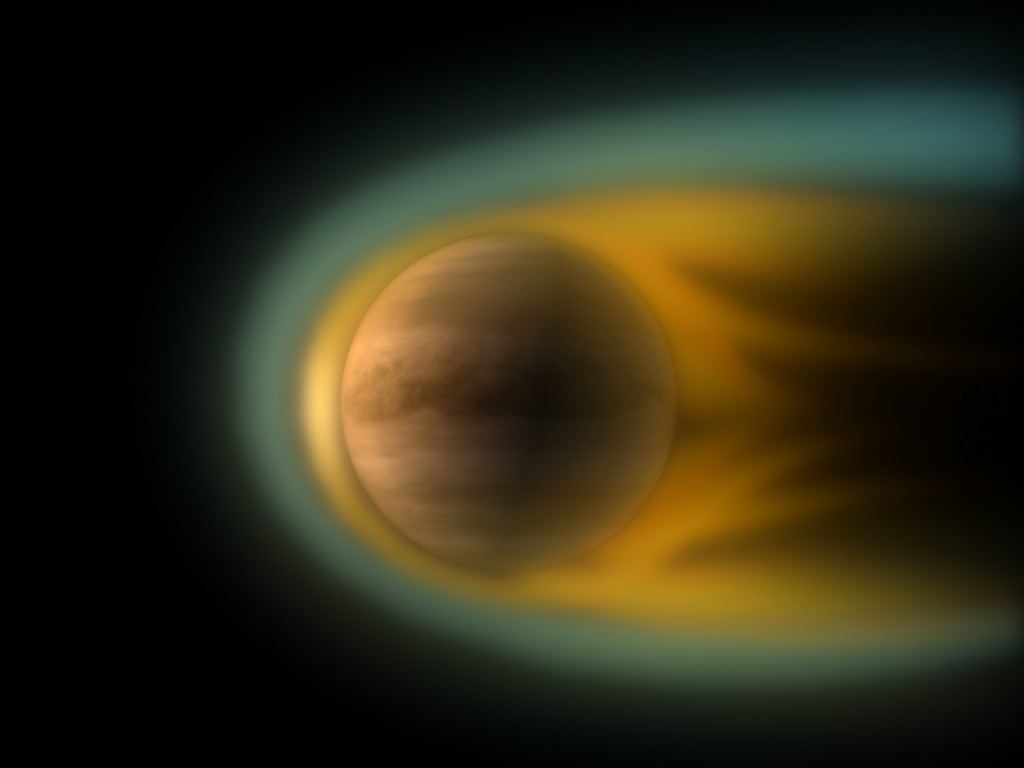The BepiColombo mission, a joint effort between JAXA and the ESA, was only the second (and most advanced) mission to visit Mercury, the least explored planet in the Solar System. With two probes and an advanced suite of scientific instruments, the mission addressed several unresolved questions about Mercury, including the origin of its magnetic field, the depressions with bright material around them (“hollows”), and water ice around its poles. As it turns out, BepiColombo revealed some interesting things about Venus during its brief flyby.
Specifically, the two probes studied a previously unexplored region of Venus’ magnetic environment when they made their second pass on August 10th, 2021. In a recent study, an international team of scientists analyzed the data and found traces of carbon and oxygen being stripped from the upper layers of Venus’ atmosphere and accelerated to speeds where they can escape the planet’s gravitational pull. This data could provide new clues about atmospheric loss and how interactions between solar wind and planetary atmospheres influence planetary evolution.
The study was led by Lina Hadid, a CNRS researcher at the Plasma Physics Laboratory (LPP) and the Observatoire de Paris. She was joined by researchers from the Institute of Space and Astronautical Science (ISAS) at JAXA, the Max Planck Institute for Solar System Research (MPS), the CNRS Research Institute in Astrophysics and Planetology (IRAP), the Laboratoire Atmosphères, Milieux, Observations Spatiales (LATMOS), the Institute for Geophysics and Extraterrestrial Physics (IGEP), the Space Research Institute (SRI), and multiple universities.
 Schematic view of planetary material escaping through Venus magnetosheath flank. Credit: Thibaut Roger/Europlanet 2024 RI/Hadid et al.
Schematic view of planetary material escaping through Venus magnetosheath flank. Credit: Thibaut Roger/Europlanet 2024 RI/Hadid et al.
While Venus does not have an intrinsic magnetic field like Earth, it has a weak magnetic field that results from the interaction of solar wind and electrically charged particles in Venus’ upper atmosphere. Surrounding this “induced magnetosphere” is the “magnetosheath,” a region where the solar wind is slowed and heated. In August 2021, BepliColombo’s two spacecraft – the ESA’s Mercury Planetary Orbiter (MPO) and JAXA’s Mercury Magnetospheric Orbiter (MMO, aka. Mio) – passed by Venus on the final leg of their journey toward Mercury, using the planet’s gravity to adjust its course and its upper atmosphere to shed speed.
The two spacecraft spent 90 minutes passing through the tail of the magnetosheath and the magnetic regions closest to the Sun. The mission controllers used this opportunity to gather data on the number and mass of charged particles it encountered using Mio‘s Mass Spectrum Analyzer (MSA) and the Mercury Ion Analyzer (MIA), which are part of the probe’s Mercury Plasma Particle Experiment (MPPE). The team also relied on Europlanet’s Sun Planet Interactions Digital Environment on Request (SPIDER) space weather modeling tools to track how atmospheric particles propagated through the magnetosheath.
As Hadid explained in a Europlanet Society release, analysis of this data provides insight into the chemical and physical processes driving atmospheric escape from this region of the magnetosheath:
“This is the first time that positively charged carbon ions have been observed escaping from Venus’s atmosphere. These are heavy ions that are usually slow moving, so we are still trying to understand the mechanisms that are at play. It may be that an electrostatic ‘wind’ is lifting them away from the planet, or they could be accelerated through centrifugal processes.”
In particular, these findings could help scientists to deduce what happened to Venus’ surface water. Like Earth, much of Venus’ surface was once covered in oceans, which disappeared about 700 million years ago. The most widely-held theory is that this coincided with a massive resurfacing event that flooded the atmosphere with carbon dioxide, leading to a runaway Greenhouse Effect that vaporized the oceans. Over time, solar wind stripped away the water, leaving a thick atmosphere over 90 times as dense as Earth’s, and composed of carbon dioxide with smaller amounts of nitrogen and trace gases.
 Artist’s impression of Venus with the solar wind flowing around the planet, which has little magnetic protection. Credit: ESA – C. Carreau
Artist’s impression of Venus with the solar wind flowing around the planet, which has little magnetic protection. Credit: ESA – C. Carreau
Two spacecraft that previously visited Venus – NASA’s Pioneer Venus Orbiter and ESA’s Venus Express -conducted detailed studies of atmospheric loss. However, their orbital paths left some areas unexplored, leaving many questions about the planet’s atmospheric dynamics unanswered. Said Moa Persson, a researcher from the Swedish Institute of Space Physics and a co-author on the study:
“Recent results suggest that the atmospheric escape from Venus cannot fully explain the loss of its historical water content. This study is an important step to uncover the truth about the historical evolution of the Venusian atmosphere, and upcoming missions will help fill in many gaps.”
Over the next decade, several more spacecraft are destined for Venus, including the ESA’s Envision mission, NASA’s Venus Emissivity, Radio Science, InSAR, Topography and Spectroscopy (VERITAS) orbiter and Deep Atmosphere Venus Investigation of Noble gases, Chemistry, and Imaging (DAVINCI) probe, and India’s Shukrayaan orbiter. Collectively, these spacecraft will characterize the Venusian environment, magnetosphere, atmosphere, surface, and interior. This research could lead to improved models that predict how once-habitable planets could become hostile to life as we know it.
Further Reading: Euro Planet Society, Nature Astronomy

